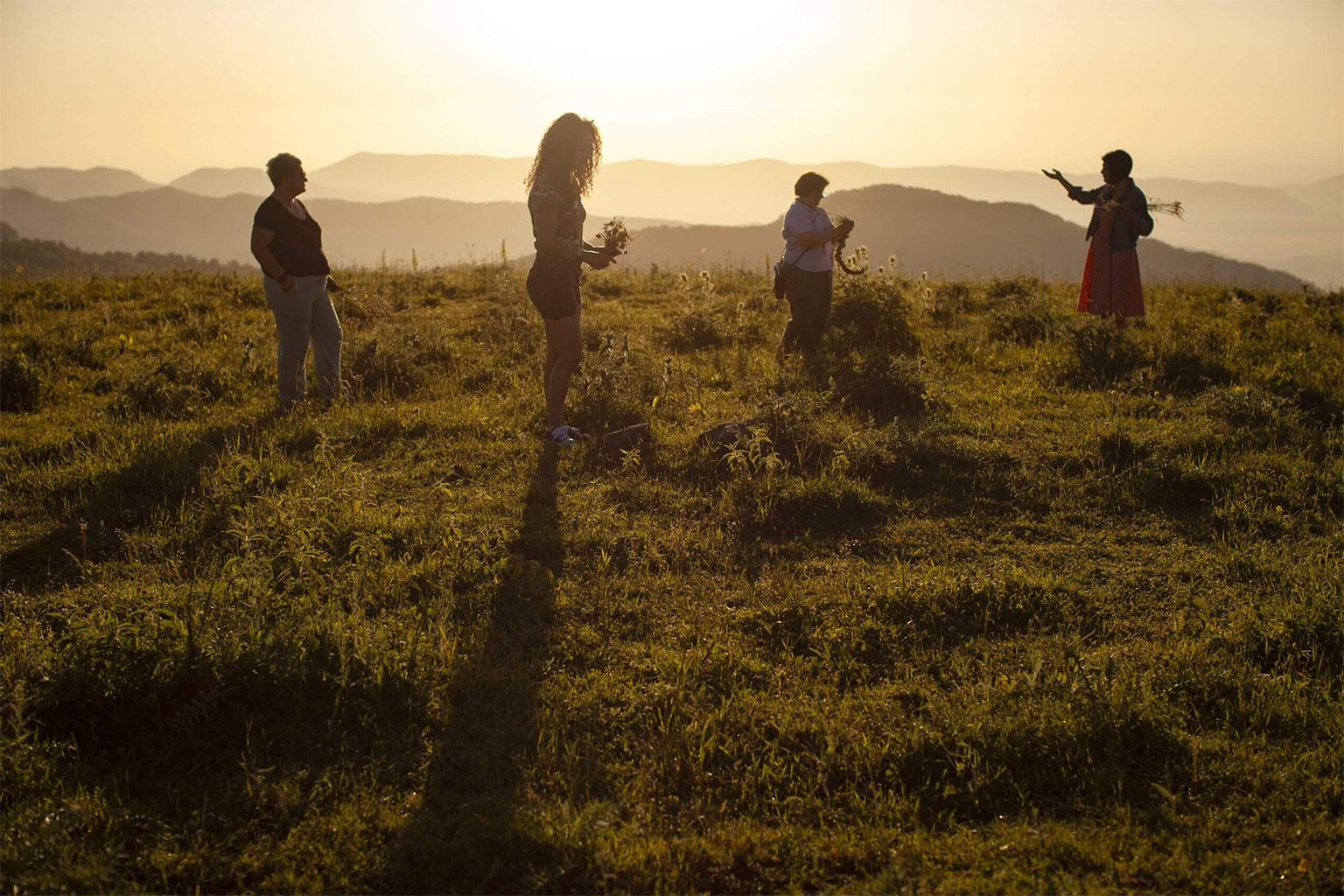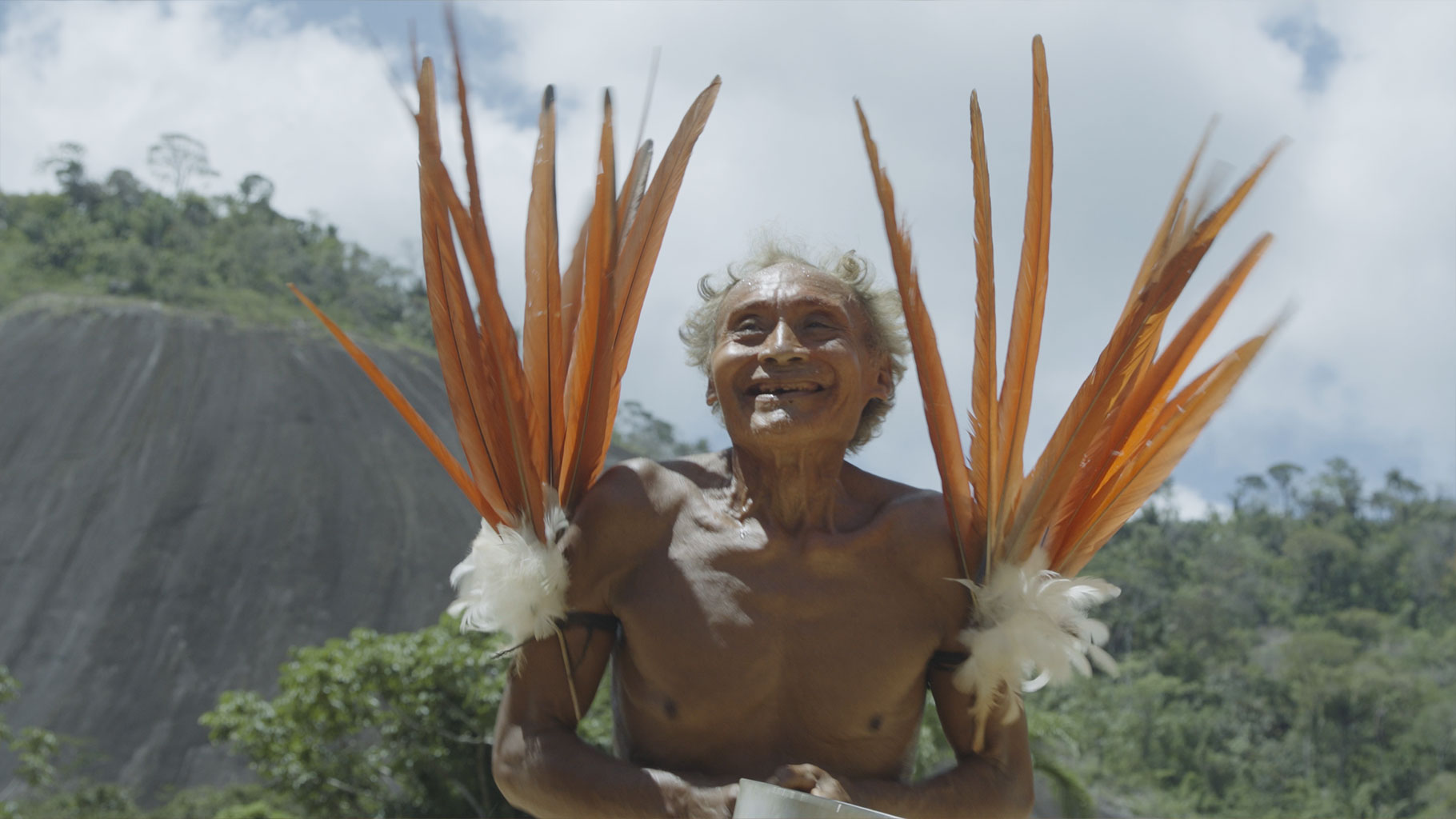
An Intergenerational Tragedy of Displacement and Land Loss
Today, although the land of Artsakh remains, the place as it was previously known and loved by its Indigenous population has ceased to exist. After three decades of tenuous peace, Azerbaijan attacked Artsakh in September 2020, and then in December 2022, blockaded the only road connecting Artsakh to Armenia. As of January 1st, 2024, all previous state institutions were dissolved. Since the 2020 war started, over 130,000 people fled their homes, becoming refugees in Armenia and other countries.
When Mkrtichian set out to make There Was, There Was Not in 2018, she had no idea that she and her subjects would get caught in a war two years later. She did, however, grow up listening to her grandparents tell Armenian fairy tales –– some of the last vestiges of their beloved culture — and was sadly familiar with the history of displacement and genocide of Armenians. During World War 1, Mkrtichian’s family was displaced from their homeland, a region in present-day Eastern Turkey.
“Artsakh is on the other side of the country,” Mkrtichian explains. “As someone who came from a family who lost these ancestral lands and were displaced, the people of Artsakh felt like they were the closest to understanding how important a tie to land was.”
“I always felt like these people really appreciated this land that they had,” she continued. “They had to fight for it. They knew how important that land was and how important it was to keep it and so I think that was some sort of tie that I felt to the people there.”


From Judo to Mine Removal: The Stories of Four Extraordinary Women
Mkrtichian moved to Armenia in 2012. She was drawn to Artsakh and made a short documentary entitled Motherland (2019), about the first team of women to remove landmines from the war in the 1990s. She later returned to teach a workshop. Enchanted by the place, she started to see, “a larger story there.”
“I was noticing all these really extraordinary women who were in this place that was objectively more difficult to live in,” she continued. “I just became really interested in how they had less access to rights and freedoms but seemed like the strongest people I’ve ever met and tend to be like doing all the work in this place. That kind of irony really drew me to telling these stories and finding a way for those women who are doing that work, who I found really extraordinary, to be seen in a different way.”
The four women at the heart of There Was, There Was Not all came into Mkrtichian’s life organically, and the depth of each friendship resonates strongly in the film. Sose Balasanyan is a world-class martial artist in Judo who has won gold medals in competitions around the world. Another lead character, Siranush Sargsyan, is a civil servant in the city government who’s campaigning for city council with a platform that champions women’s rights. Her efforts are complemented by Gayane Hambardzumyan, founder of the only Women’s Center in the Republic of Artsakh. Lastly, single mother Sveta Harutunyan is one of the first and only women to take on the harrowing job of removing mines previously left during war efforts. The women represent different backgrounds, generations and personalities, but they share incredible qualities of strength, resilience, and compassion.
Mkrtichian employs a subtle show-don’t-ell approach, visiting each woman in her daily life and witnessing tender moments each experiences with family, food, and the land. In the early years of making the film, Mkrtichian worked with cinematographers, but came to recognize that “the relationship that I was establishing with the four women was moving into this more intimate space and felt more like a friendship.”
“By the time I was in the third year of filming, it felt like just being in a room by myself was actually the way that I was getting the footage that felt most organic to me,” she explains.
This focus on the quiet power with which her protagonists moved through everyday life was Mkrtichian’s primary goal. In her director’s statement, she writes, “I never meant to make a film that documented war, displacement, and ethnic cleansing. I meant to make a film about how women create a sense of home and a better future for their communities, after the rupture of war, displacement, and ethnic cleansing. But history repeats itself.”

Emily Mkrtichian and Sose Balasanyan at True/False Film Festival in Columbia, Missouri, in February 2024
An Unexpected Plot Twist: War and Displacement
In 2020, just as she thought she was nearing the end of production, Mkrtichian found herself caught in a war — just two days before her flight home.
“I got a call from [Judo champion] Sose [Balasanyan] at like 7:00am, telling me that bombs were dropping,” Mkrtichian recalls. “From that moment, it was a very different relationship with a camera… it felt like the camera was like a lifeline… it started to feel like it was like a crucial act — a radical act — just to have this camera and to follow these women.”
With no prior experience in wartime conflict, Mkrtichian found herself concerned primarily with the safety of the four women. She called upon journalist friends to advise on protocol for filming under such challenging circumstances. At this same time, three years into filming, she received her first funding for the film, from Sundance Institute.
Balasanyan joined Mkrtichian at the world premiere at True/False Film Festival in Columbia, Missouri, in February 2024. With Mkrtichian serving as translator, Balasanyan shared her feelings about the recent, painful loss of her land.
“Honestly, she would never have never imagined that she would have to leave that place,” Mkrtichian translated. “They really overcame everything. They overcame a blockade. They overcame being attacked with these kinds of weapons that you can’t respond to.”
“For hundreds of years, Armenians have always lived in that place, and they’ve always struggled for it,” she continued. “Even after the war, everything was uncertain and hundreds of people came back to Artsakh not knowing the future, knowing that it wasn’t safe, knowing that the borders were moving and there were still bombings. People still wanted to live in that place.”
When it became clear that no international aid was coming, Balasanyan and others in Artsakh felt really alone.
“The Russians weren’t helping; Armenia couldn’t do anything. No one from the European Union stepped in,” translated Mkrtichian. “Within three days, everyone decided to leave. Over 120,000 people decided to leave these lands, which tells you how scared everyone was.”
“The media narrative was, ‘Oh, they just decided to leave.’” translated Mkrtichian. “How do 120,000 people decide to leave a place unless everyone really feels that their lives are in danger? Especially a place that they fought for for hundreds of years?”
“It was really hard to make that decision [to leave],” Mkrtichian translated, of Balasanyan’s experience. “They’re believing and dreaming that one day they’ll be able to go back to this place.”

Crafting the Story: Finding the Nuances
While editing the material, Mkrtichian found herself longing for a partner who could help her craft the nuanced kind of story she was trying to tell. Specifically, she sought to ensure that the film “was really steering clear of sensationalizing the war, the violence of it and really focusing on the more quiet, patient stories of these women.”
“This is an industry, and I feel like films are made in certain ways,” she comments. “People want them to be successful for larger audiences, and often that means catering to a certain way of witnessing war.”
Fortunately, Mkrtichian found a collaborator and mentor in Alexandria Bombach (On Her Shoulders, Frame By Frame), a director, cinematographer and editor known for documentaries which tell the stories of extraordinary people navigating the aftermath of genocide and war. Bombach, one of the film’s Executive Producers, first joined There Was, There Was Not as a story consultant in 2019 and later joined as editor. Bombach’s support instilled confidence in Mkrtichian to realize her vision and make the film she wanted to make.
“In the edit, we leaned into the fact that Emily was making a completely different film before the war broke out,” Bombach says. “I think many directors would have skipped over that footage, but Emily had the instinct to listen to what the footage was saying and what it meant to the larger story. Her compassion and integrity created a profoundly authentic portrayal of a devastating situation — told through a deep connection with these four women and with Artsakh.”
“[Alexandria was] just such a beautiful collaborative partner and brought so many things to this film that I wouldn’t have had the skills to do,” shares Mkrtichian. “I think that the most important thing for them was to listen to what was important in the way that I wanted to tell the story. I’m really glad that I found someone who helped strengthen that for me, because I think that’s what people are reacting to now when they watch it.”
Despite the trauma and sorrow, Mkrtichian found a way to close There Was, There Was Not that invokes the beloved fairy tales her grandparents told her. The final shots are stunning — almost otherworldly — as all four women gather together for the first time, on a mountaintop as the setting sun casts a golden light over the green hills.
“I really wanted to find a way for us to just have a beautiful place and to film something that felt like it was in another world,” reflects Mkrtichian. “But it took years for me to understand how to use it, because I think I still couldn’t quite wrap my head around how to imagine something different than the horror that we had seen.”
“Eventually, coming back to that theme of fairy tales and stories and that idea of why passing things on is so important,” she continues. “I think I came to feel like that was the work of this film, to reopen that portal to some sort of better future.”
Ω






